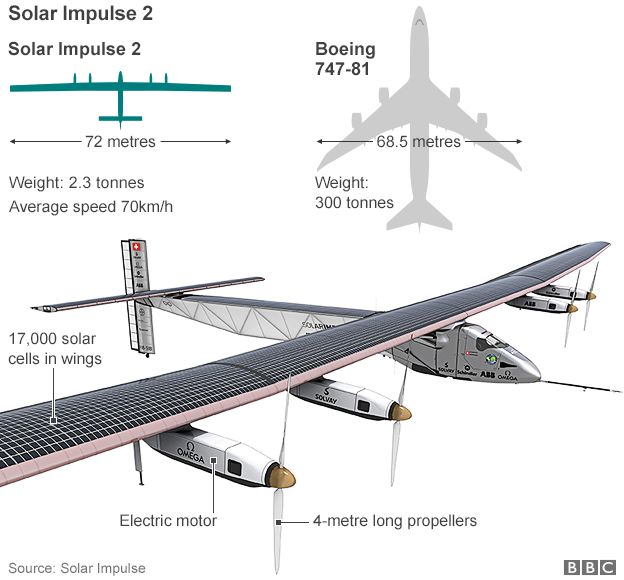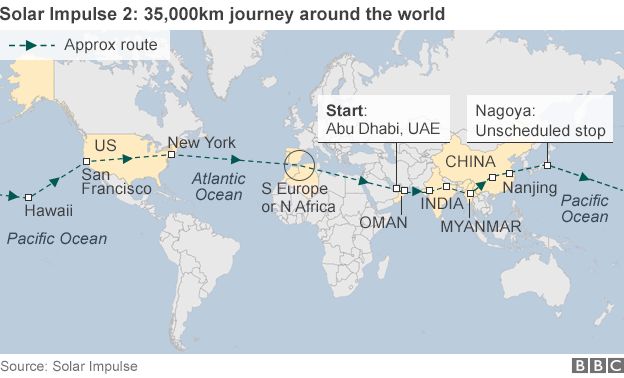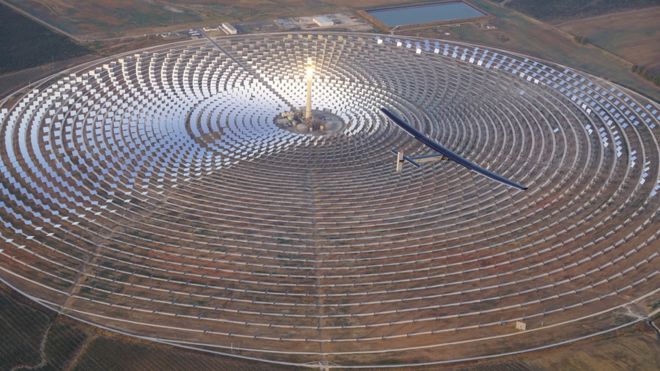Solar Impulse has begun what should be its penultimate flight, leaving Seville in Spain bound for Cairo in Egypt.
It should take the zero-fuel aircraft somewhere between 48 and 72 hours, depending on the weather conditions encountered en route.
Solar Impulse is now in the home straight of its bid to circumnavigate the globe.
After this leg, there is just the final hop to Abu Dhabi where the challenge began in March 2015.
The two pilots who have shared the flying duties around the world are each taking one more turn at the controls.
Andre Borschberg is running the Seville-Cairo stage; Bertrand Piccard will complete the challenge by taking Solar Impulse back into the UAE.
Mission managers want to land in Egypt in the morning when the winds and temperatures will be most favourable.
And they will have to be particularly careful not to expose the solar cells on the plane to too much heat when it is stationary on the ground in Cairo.
If Solar Impulse is not in Egypt ready to touch down on Wednesday morning, it will wait in the sky until Thursday morning.
“The winds for landing are good from about 2am until 8am,” explained flight director Raymond Clerc.
“Then, if we were to land afterwards, the temperatures on the ground would be too high, and it would be a problem for the structure [as we move Solar Impulse to the hanger]. If we’re flying, it’s not a problem because we’re ventilated by the air speed.”

Before taking off from Seville International Airport at 04:20 GMT, Andre Borschberg said he inevitably felt the emotion of making his last journey in the plane.
“It’s meaningful obviously because it’s my last flight in this round-the-world epic. I’ve started to think about it. I’m happy that we get close to the end but also prudent knowing that it is not done yet. I have to stay really focussed.”
This penultimate leg crosses seven countries and as well as having to negotiate busy air routes, the slow-moving plane has to take account of a number of military operations in the Mediterranean/North Africa region.
If the opportunity arises, Solar Impulse will stage a photoshoot before landing just above the pyramids. But this is likely to depend on getting the right lighting.
For Bertrand Piccard, going to Egypt is an important milestone for the project he founded. Egypt is where he landed 17 years ago in Breitling Orbiter 3 – the first balloon to make a non-stop, round-the-world flight.
“We arrived there with so little fuel left – you know, the propane gas you have to burn in your envelope to stay airborne. I landed there with less than 1% of our reserves, and I was really scared to fall short of gas before the end. And that’s when I said I want to fly around the world again but with no fuel,” the Swiss adventurer said.

Mr Piccard and Mr Borschberg have been working on the Solar Impulse project for more than a decade.
Their plane is wider than a 747 jumbo jet but weighs just 2.3 tonnes, which poses some unique challenges:
- The aircraft is very sensitive to the weather conditions
- But its solar cell and battery efficiency is very high
- This means it can stay aloft for many days and nights
- The pilot is permitted only catnaps of up to 20 minutes
- The cockpit is little bigger than a public telephone box

LEG 1: 9 March. Abu Dhabi (UAE) to Muscat (Oman) – 772km; 13 Hours 1 Minute
LEG 2: 10 March. Muscat (Oman) to Ahmedabad (India) – 1,593km; 15 Hours 20 Minutes
LEG 3: 18 March. Ahmedabad (India) to Varanasi (India) – 1,170km; 13 Hours 15 Minutes
LEG 4: 18 March. Varanasi (India) to Mandalay (Myanmar) – 1,536km; 13 Hours 29 Minutes
LEG 5: 29 March. Mandalay (Myanmar) to Chongqing (China) – 1,636km; 20 Hours 29 Minutes
LEG 6: 21 April. Chongqing (China) to Nanjing (China) – 1,384km; 17 Hours 22 Minutes
LEG 7: 30 May. Nanjing (China) to Nagoya (Japan) – 2,942km; 1 Day 20 Hours 9 Minutes
LEG 8: 28 June. Nagoya (Japan) to Kalaeloa, Hawaii (US) – 8,924km; 4 Days 21 Hours 52 Minutes
LEG 9: 21 April. Kalaeloa, Hawaii (US) to Mountain View, California (US) – 4,523km; 2 Days 17 Hours 29 Minutes
LEG 10: 2 May. Mountain View, California (US) to Phoenix, Arizona (US) – 1,199km; 15 Hours 52 Minutes
LEG 11: 12 May. Phoenix, Arizona (US) to Tulsa, Oklahoma (US) – 1,570 km; 18 Hours 10 Minutes
LEG 12: 21 May. Tulsa, Oklahoma (US) to Dayton, Ohio (US) – 1,113 km; 16 Hours 34 Minutes
LEG 13: 25 May. Dayton, Ohio (US) to Lehigh Valley, Pennsylvania (US) – 1,044 km; 16 Hours 47 Minutes
LEG 14: 11 June. Lehigh Valley, Pennsylvania (US) to New York (US) – 230km; 4 Hours 41 Minutes
LEG 15: 20 June. New York (US) to Seville (Spain)
Jonathan.Amos-INTERNET@bbc.co.uk and follow me on Twitter: @BBCAmos
This article was originally published by BBC.com

